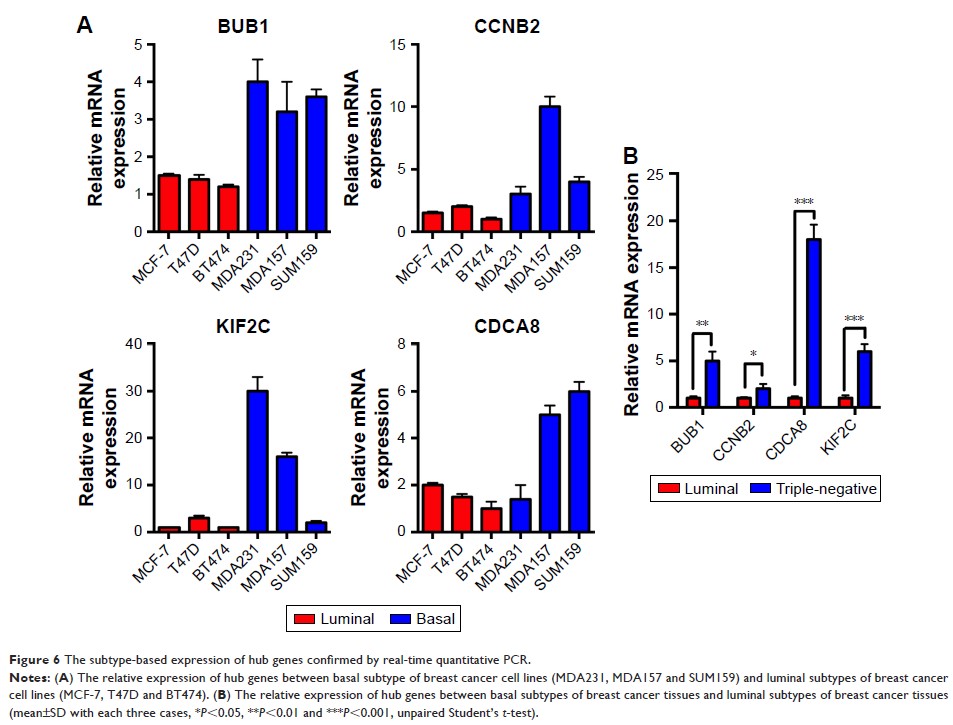9 0 5 7 8
论文已发表
注册即可获取德孚的最新动态
IF 收录期刊
- 2.6 Breast Cancer (Dove Med Press)
- 3.9 Clin Epidemiol
- 3.3 Cancer Manag Res
- 3.9 Infect Drug Resist
- 3.6 Clin Interv Aging
- 4.8 Drug Des Dev Ther
- 2.8 Int J Chronic Obstr
- 8.0 Int J Nanomed
- 2.3 Int J Women's Health
- 3.2 Neuropsych Dis Treat
- 4.0 OncoTargets Ther
- 2.2 Patient Prefer Adher
- 2.8 Ther Clin Risk Manag
- 2.7 J Pain Res
- 3.3 Diabet Metab Synd Ob
- 4.3 Psychol Res Behav Ma
- 3.4 Nat Sci Sleep
- 1.9 Pharmgenomics Pers Med
- 3.5 Risk Manag Healthc Policy
- 4.5 J Inflamm Res
- 2.3 Int J Gen Med
- 4.1 J Hepatocell Carcinoma
- 3.2 J Asthma Allergy
- 2.3 Clin Cosmet Investig Dermatol
- 3.3 J Multidiscip Healthc

运用生物信息学分析法对基底样乳腺癌中的关键通路和中枢基因进行鉴定
Authors Yang K, Gao J, Luo M
Received 1 December 2017
Accepted for publication 7 February 2018
Published 18 February 2019 Volume 2019:12 Pages 1319—1331
DOI https://doi.org/10.2147/OTT.S158619
Checked for plagiarism Yes
Review by Single-blind
Peer reviewers approved by Dr Cristina Weinberg
Peer reviewer comments 3
Editor who approved publication: Dr Ingrid Espinoza
Background: Basal-like
breast cancer (BLBC) is the most aggressive subtype of breast cancer (BC) and
links to poor outcomes. As the molecular mechanism of BLBC has not yet been
completely discovered, identification of key pathways and hub genes of this
disease is an important way for providing new insights into exploring the
mechanisms of BLBC initiation and progression.
Objective: The aim
of this study was to identify potential gene signatures of the development and
progression of the BLBC via bioinformatics analysis.
Methods and results: The
differential expressed genes (DEGs) including 40 up-regulated and 21
down-regulated DEGs were identified between GSE25066 and GSE21422 microarrays,
and these DEGs were significantly enriched in the terms related to oncogenic or
suppressive roles in BLBC progression. In addition, KEGG pathway and GSEA (Gene
Set Enrichment Analysis) enrichment analyses were performed for DEGs between
the basal type and non-basal-type breast cancer from GSE25066 microarray. These
DEGs were enriched in pathways such as cell cycle, cytokine-cytokine receptor
interaction, chemokine signaling pathway, central carbon metabolism signaling
and TNF signaling pathway. Moreover, the protein-protein interaction (PPI)
network was constructed with those 61 DEGs using the Cytoscape software, and
the biological significance of putative modules was established using MCODE.
The module 1 was found to be closely related with a term of mitosis regulation
and enriched in cell cycle pathway, and thus confirmed the pathological
characteristic of BLBC with a high mitotic index. Furthermore, prediction
values of the top 10 hub genes such as CCNB2 , BUB1 , NDC80 , CENPE , KIF2C , TOP2A , MELK , TPX2 , CKS2 and KIF20A were validated using Oncomine and
Kaplan-Meier plotter.
Conclusion: Our
results suggest the intriguing possibility that the hub genes and modules in
the PPI network contributed to in-depth knowledge about the molecular mechanism
of BLBC, paving a way for more accurate discovery of potential treatment
targets for BLBC patients.
Keywords: basal-like
breast cancer, bioinformatics, differentially expressed genes, hub genes,
molecular mechanism
